Technical Insulation Market Size and Trends
The technical insulation market is estimated to be valued at USD 11.56 Bn in 2025 and is expected to reach USD 17.39 Bn by 2032, growing at a compound annual growth rate (CAGR) of 6.0% from 2025 to 2032.
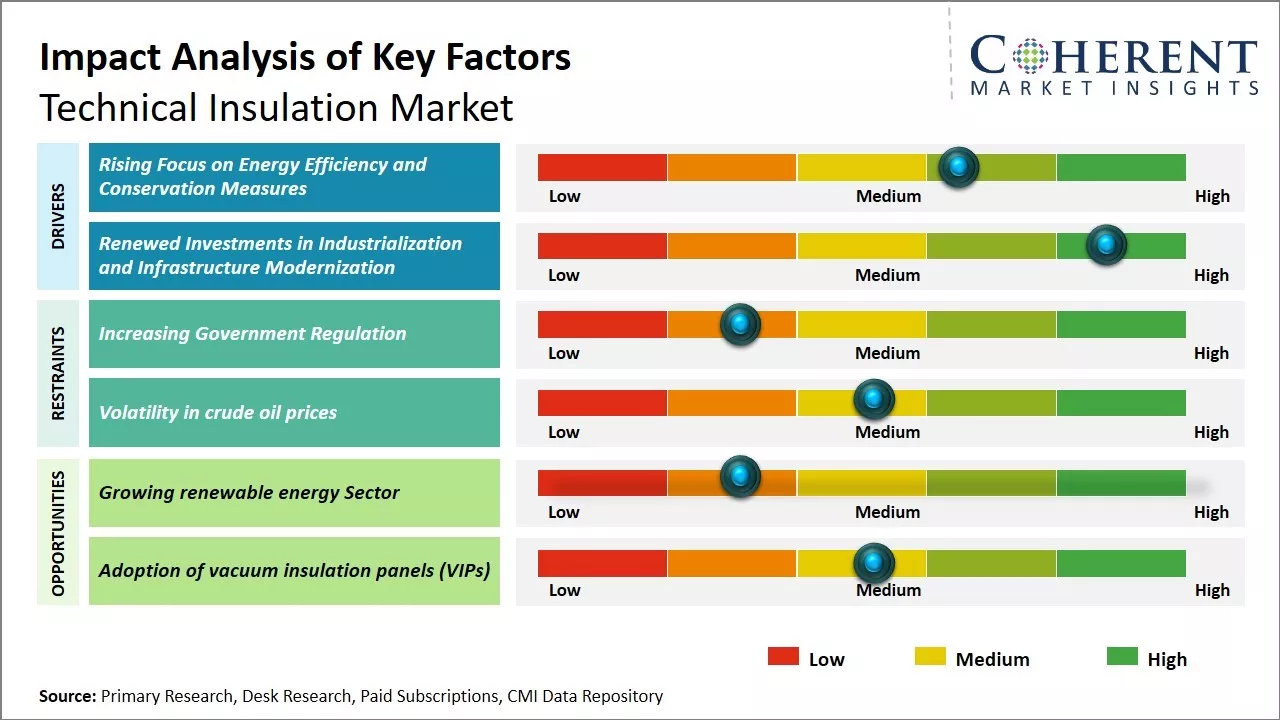
Discover market dynamics shaping the industry: Download Free Sample
The market is primarily driven by the growth in the construction and HVAC industries along with stringent energy efficiency regulations worldwide. The demand for technical insulation is expected to rise significantly during the forecast period. Growing infrastructure development and industrialization activities are increasing the requirement of technical insulation solutions in various end-use industries. Furthermore, focus towards minimization of energy losses and emphasis on sustainability are promoting the adoption of technical insulation. Key players operating in the market are focused on investing in research and development to introduce innovative and eco-friendly insulation materials.
Rising Focus on Energy Efficiency and Conservation Measures
With the growing threat of climate change and rising energy costs, businesses and governments across the world are making immense efforts to reduce their carbon footprint and optimize energy usage. Various energy efficiency initiatives and conservation mandates have been introduced that are driving higher demand for technical insulation solutions. Technical insulation helps improve the overall thermal performance of industrial facilities, commercial buildings, and infrastructure by reducing heat transfer. This leads to lower energy consumption for heating and cooling systems. Many countries have implemented strict building energy codes and appliances standards requiring minimum insulation levels. Complying with such regulations has become imperative for obtaining construction approvals and certification. Technical insulation manufacturers are promoting their products as enablers to meet these statutory norms. The oil and gas industry is also focusing on insulation for improved thermal efficiency of pipelines, vessels, and equipment used in production, transportation as well as downstream processes. Insulation helps curb methane leakage which is a potent greenhouse gas. Furthermore, insulation plays a key role in process and industrial energy optimization strategies of companies across heavy manufacturing sectors. It aids in harnessing wasted or unused heat for subsequent applications to boost overall process yields.
Market Concentration and Competitive Landscape
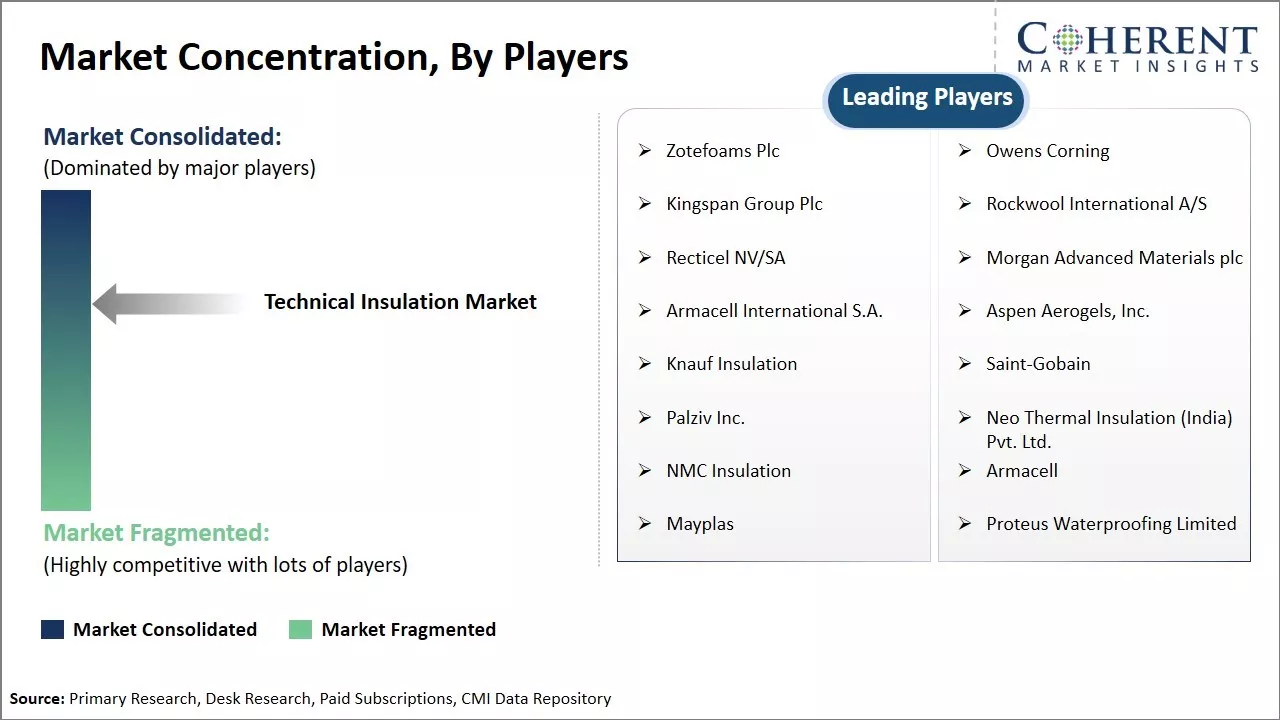
Get actionable strategies to beat competition: Download Free Sample
Renewed Investments in Industrialization and Infrastructure ModernizationAfter facing economic slowdowns and disruptions in the recent past, governments worldwide are pursuing ambitious plans to modernize their aging infrastructure and step up domestic manufacturing capacities. For instance, according to data published by the Council on Foreign Relations in November 2021, the Congress approved a historic investment in the U.S. infrastructure that included hundreds of billions of dollars in new spending. Massive investments are being routed towards expanding oil and gas extraction and transportation networks, upgrading ageing power grids, setting up new industrial parks, and modernizing public works infrastructure such as bridges, tunnels, roads, and railways. All such large scale development undertakings involve the extensive use of technical insulation solutions. Industrial units and heavy machinery commonly employ insulation wraps, sheets, tubes, coatings, and adhesives for thermal management, explosion prevention, and noise control. Growing megaprojects in the refinery, petrochemical, and energy sectors are the major demand drivers for high temperature and cryogenic insulation materials. Even commercial applications such as district cooling systems, building exteriors, piping, and ductwork require specialized insulation variants. Governments see infrastructure-led growth as a catalyst for job creation and economic revival in the post-pandemic era. Sustained government outlays towards mega construction projects will significantly benefit insulation product manufacturers and installation service providers over the coming years. Rising industrial competitiveness across developing nations will further propel investments in advanced insulation-dependent facilities.
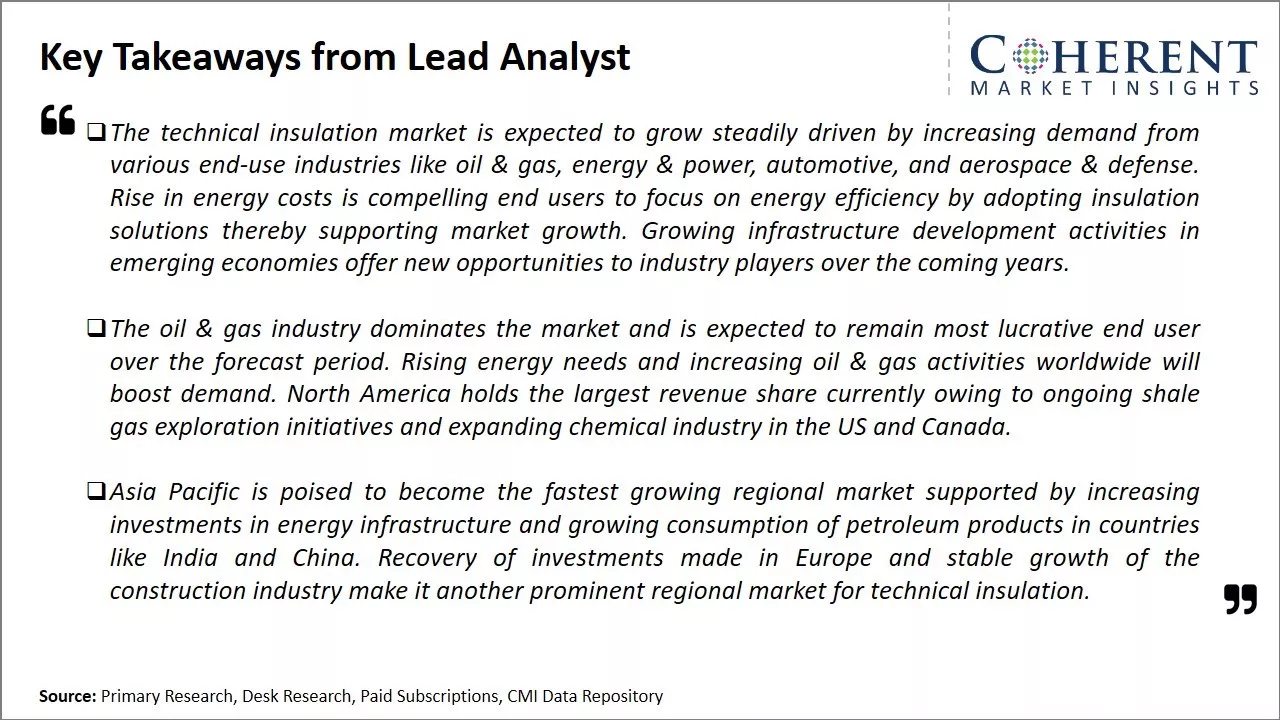
To learn more about this report, Download Free Sample
Market Challenges: Increasing Government RegulationThe technical insulation market faces several challenges. Regulations restricting the use of materials containing VOCs and formaldehyde are becoming more stringent. This is increasing pressure on manufacturers to develop greener, sustainable insulation solutions. Additionally, stringent energy efficiency codes in many countries are raising the performance standards for insulation products. Developing highly effective insulators while keeping costs competitive remains a challenge. Infrastructure in emerging markets still relies on older, energy-inefficient technologies, restricting market growth.
Market Opportunities: Growing renewable energy Sector
The emphasis on renewable energy and achieving carbon emission targets is driving the demand for insulation in applications like district heating systems, wind turbines, and solar PV installations. Refurbishing aged infrastructure with energy-efficient insulation upgrades can tap into an untapped potential. Moreover, rising environmental awareness is motivating industries and plants to opt for green insulation materials.
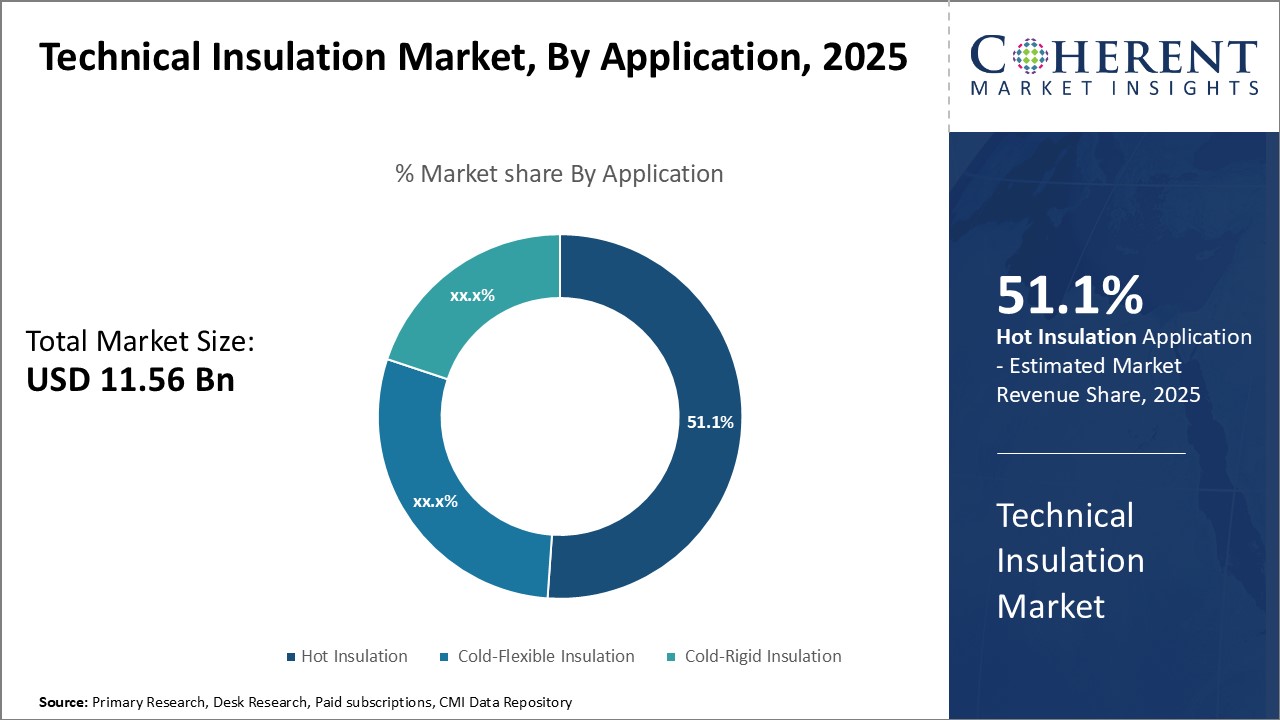
Discover high revenue pocket segments and roadmap to it: Download Free Sample
Insights, By Type: Reliable Insulation for Critical ApplicationsIn terms of type, hot insulation contributes 51.1% share of the technical insulation market owing to its ability to withstand high temperatures efficiently. Hot insulation materials like mineral wool and calcium silicate are increasingly being used across industries that involve high-temperature applications and processes. Their properties of low thermal conductivity and ability to maintain insulation performance even at elevated temperatures make them indispensable for critical systems and equipment. Mineral wool remains one of the most popular choices for hot insulation due to its reliable fire resistance up to 1,000°C and cost-effectiveness. It is widely used for insulating industrial applications like ovens, furnaces, boilers, and fireproof ducts. Calcium silicate is another fire-resistant material gaining ground in high-temperature insulation owing to its thermal shock resistance and high compressive strength. Its moisture resistance enables withstanding wet industrial processes without any loss in insulation values.
Insights, By Application: Ensuring Efficiency of Building HVAC Systems
In terms of application, heating & plumbing contributes the highest share of the technical insulation market due to the extensive need for thermal management in building systems. Heating, ventilation and air conditioning (HVAC) systems are integral to commercial and residential infrastructure for maintaining desired indoor temperatures. Insulation plays a vital role in improving the energy efficiency of HVAC equipment and associated piping networks. Cellular glass and rock mineral wool are commonly used insulation materials for HVAC applications due to their durable moisture resistance and consistent insulation properties. Their ability to retain heat at uniform levels optimizes heat transfer in pipes carrying hot water or steam. This reduces distribution losses and lowers operating costs of heating systems over the long run. Flexible elastomeric foams also gain popularity for plumbing insulation due to the ease of applying thin insulation layers around piping joints and valves.
Insights, By End-Use: Achieving Energy Savings in Industrial Processes
In terms of end-use, industrial & OEM contributes the largest share of the technical insulation market owing to extensive insulation needs of various equipment and applications. Thermal management plays a vital role in optimizing energy usage within industrial facilities as even small heat losses can translate to massive waste. Technical insulations effectively minimize these losses across a wide range of equipment used in manufacturing processes. Mineral wool remains a top choice for industrial insulation due to its durability and stability across harsh environments. It is extensively used to insulate ovens, dryers, ductwork, and pipe lines within sectors like oil & gas, cement, power and automotive. Flexible elastomeric foams are also gaining prominence due to their vibration dampening properties and ability to insulate irregular surfaces. For instance, according to data published by the International Trade Administration, the U.S. Department of Commerce in 2024, the U.S. is the world's second-largest market for vehicle sales and production. They are suitable for equipment with moving parts or complex geometries that are difficult to insulate with other materials.
Regional Insights
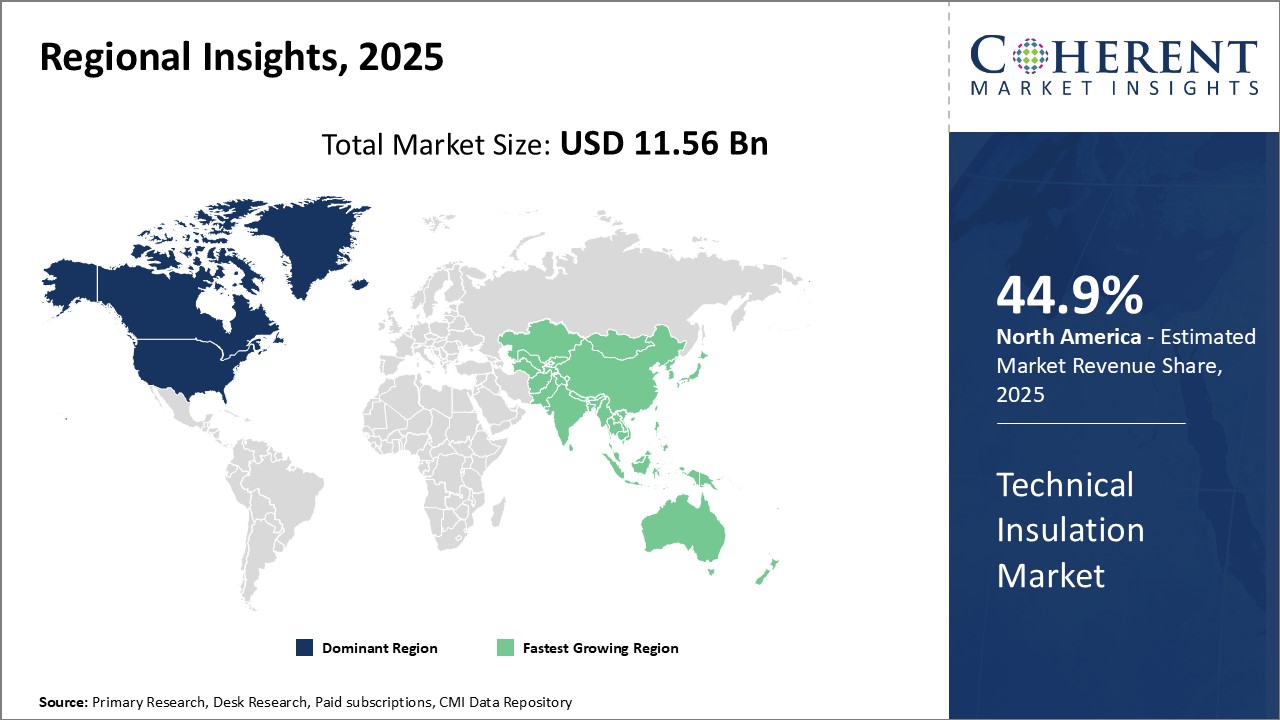
Need a Different Region or Segment? Download Free Sample
North America dominates the global technical insulation market with 44.9% of the market share owing to the strong presence of major end-use industries in the region. With well-established oil & gas, energy & power, automotive and aerospace sectors, the demand for technical insulation is ever increasing in the U.S. and Canada. The region accounts for over 30.5% of the global oil & gas production, thus new pipeline projects and expansion of existing infrastructure is constantly driving the sales of technical insulation materials. Moreover, presence of leading insulation manufacturers who are engaged in production of wide variety of insulation materials such as calcium silicate, mineral wool and flexible elastomeric foam has made North America a price leader in the global market.
The Asia Pacific region is recognized as the fastest growing market for technical insulation globally. Rapid industrialization and infrastructure development in countries such as China, India, and Japan has strengthened the need for energy efficient insulation systems. China itself accounts for over 25.5% of the world's manufacturing output and over 30.5% of global oil consumption. This has pumped huge investments in process industry plants, pipeline networks, refineries, and petrochemical facilities which act as primary consumers of technical insulation. Further, price sensitive nature of APAC's end use industries has encouraged domestic production of technical insulation in the region. New manufacturing facilities by international as well as local players are being set up to cater to the rising demand. Export of technical insulation materials from APAC remains moderate as local consumption is high, albeit China has emerged as a key exporter to other developing Asian markets.
Market Report Scope
Technical Insulation Market Report Coverage
| Report Coverage | Details | ||
|---|---|---|---|
| Base Year: | 2024 | Market Size in 2025: | USD 11.56 Bn |
| Historical Data for: | 2020 To 2024 | Forecast Period: | 2025 To 2032 |
| Forecast Period 2025 to 2032 CAGR: | 6.0% | 2032 Value Projection: | USD 17.39 Bn |
| Geographies covered: |
|
||
| Segments covered: |
|
||
| Companies covered: |
Zotefoams Plc, Owens Corning, Kingspan Group Plc, Rockwool International A/S, Recticel NV/SA, Morgan Advanced Materials plc, Armacell International S.A., Aspen Aerogels, Inc., Knauf Insulation, Saint-Gobain, Palziv Inc., Neo Thermal Insulation (India) Pvt. Ltd., NMC Insulation, Armacell, Mayplas, and Proteus Waterproofing Limited |
||
| Growth Drivers: |
|
||
| Restraints & Challenges: |
|
||
Uncover macros and micros vetted on 75+ parameters: Get instant access to report
Technical Insulation Industry News
- In March 2022, Saint-Gobain, a French multinational corporation through its insulation subsidiary ISOVER, announced its investment in the coming years to increase its glass wool production capacity in France and support the growth of the energy renovation market
- Owens Corning introduced PINK Next Gen Fiberglas insulation in August 2021, featuring advanced fiber technology. This innovation offers benefits such as up to 23% faster installation compared to previous products, increased comfort during installation due to reduced dust, and enhanced resiliency from a tightly woven network of soft, fine fibers
- In February 2020, Rockwool A/S acquired Paroc's acoustic ceilings business, which operates under the sub-brand of Parafon Group. This acquisition expanded Rockwool's portfolio of ceiling products, including acoustic ceiling panels and insulation solutions. The company's stone wool technology is used to manufacture a variety of ceiling products, aimed at improving comfort, privacy, and energy efficiency in commercial and residential buildings.
- In July 2021, Rockwool A/S commenced the commercial production of stone wool insulation products at its manufacturing facility in Ranson, West Virginia. The 136-acre site began producing stone wool insulation for residential, commercial, and industrial uses, representing a significant investment in the local community and the company's commitment to sustainable and resilient construction solutions.
*Definition: The technical insulation market pertains to materials that are used to insulate heat exchangers, pipes, ducts, tanks, and other equipment and infrastructure typically found in industrial and commercial settings. Technical insulation products help maintain optimal temperature levels for HVAC systems, boilers, refrigeration and cryogenic equipment, and other machinery by reducing unwanted heat transfer.
Market Segmentation
- Application Insights (Revenue, USD Bn & KT, 2020 - 2032)
- Hot Insulation
- Cold-Flexible Insulation
- Cold-Rigid Insulation
- Application Insights (Revenue, USD Bn & KT, 2020 - 2032)
- Heating & Plumbing
- HVAC
- Acoustic
- Others (Refrigeration, etc.)
- End-use Insights (Revenue, USD Bn & KT, 2020 - 2032)
- Industrial & OEM
- Energy
- Others (Commercial Buildings, etc.)
- Regional Insights (Revenue, USD Bn & KT, 2020 - 2032)
- North America
- U.S.
- Canada
- Latin America
- Brazil
- Argentina
- Mexico
- Rest of Latin America
- Europe
- Germany
- U.K.
- Spain
- France
- Italy
- Russia
- Rest of Europe
- Asia Pacific
- China
- India
- Japan
- Australia
- South Korea
- ASEAN
- Rest of Asia Pacific
- Middle East & Africa
- GCC Countries
- Israel
- Rest of Middle East & Africa
- North America
- Key Players Insights
- Zotefoams Plc
- Owens Corning
- Kingspan Group Plc
- Rockwool International A/S
- Recticel NV/SA
- Morgan Advanced Materials plc
- Armacell International S.A.
- Aspen Aerogels, Inc.
- Knauf Insulation
- Saint-Gobain
- Palziv Inc.
- Neo Thermal Insulation (India) Pvt. Ltd.
- NMC Insulation
- Armacell
- Mayplas
- Proteus Waterproofing Limited
Share
Share
About Author
Pankaj Poddar is a seasoned market research consultant with over 12 years of extensive experience in the fast-moving consumer goods (FMCG) and plastics material industries. He holds a Master’s degree in Business Administration with specialization in Marketing from Nirma University, one of India’s reputed institutions, which has equipped him with a solid foundation in strategic marketing and consumer behavior.
As a Senior Consultant at CMI for the past three years, he has been instrumental in harnessing his comprehensive understanding of market dynamics to provide our clients with actionable insights and strategic guidance. Throughout his career, He has developed a robust expertise in several key areas, including market estimation, competitive analysis, and the identification of emerging industry trends. His approach is grounded in a commitment to understanding client needs thoroughly and fostering collaborative relationships. His dedication to excellence and innovation solidifies his role as a trusted advisor in the ever-evolving landscape of not only FMCG but also chemicals and materials markets.
Missing comfort of reading report in your local language? Find your preferred language :
Transform your Strategy with Exclusive Trending Reports :
Frequently Asked Questions
EXISTING CLIENTELE
Joining thousands of companies around the world committed to making the Excellent Business Solutions.
View All Our Clients
